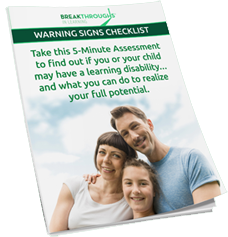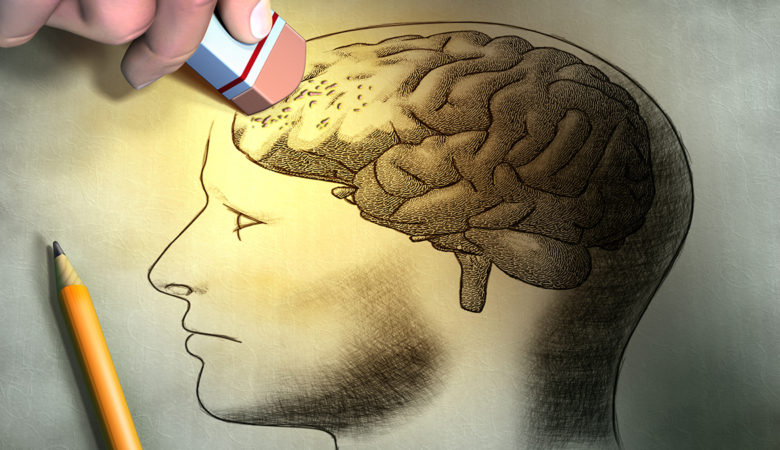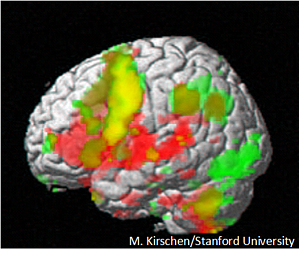
Does it affect life at home, at school or at work?
Take 5 minutes to complete the Warning Signs Checklist and discover whether you or your child could have learning difficulties that are impacting your life, and what to do about it.
Take The Free Warning Signs Checklist!
 This is the first in a series of blogs about six different areas of Memory.
This is the first in a series of blogs about six different areas of Memory.Memory problems are not reserved for the “Over 60” crowd. From elementary students to adults, many suffer from memory weaknesses without realizing it. Breakthroughs assesses six different types of memory and this article is the first in a series of blogs about each type, and how they affect our lives.
First, let’s learn about Long Term Visual Memory
According to T. Brady from M.I.T., “one of the major lessons of memory research has been that human memory is fallible, imprecise, and subject to interference.” There are, of course, exceptions to every rule. We can probably all think of a friend or Aunt that can remember obscure facts from long ago in vivid detail. However, most people are not that Aunt, and challenges with long term visual memory are more common than you may think. In our initial interviews, students frequently describe their study habits as “last minute cramming”. They often say something like “if I study too far ahead of the exam, I just lose the information.” Others will say, “I know I studied this. I can even describe the picture on the page, but I can’t quite get the information I need.” For adults not attending school, it may show up as difficulty recalling details of a book that they are reading, a training manual or a report at work. Review of their assessment results often points at long term visual memory as the culprit.
Of course, there can be other causes, such as reading level, comprehension, focus etc., but visual memory is a problem seen from Grade 1 through to our senior citizens.

This fMRI brain scan shows different areas of the brain responsible for memory. Green areas are used in visual memory, red areas are used for auditory memory and yellow areas are used for both. Remember, we’re focusing on visual memory for now.
At Breakthroughs, Long Term Visual Memory is separated and assessed as two types, visual storage and visual retrieval. The storage score indicates the brain’s ability to store and retain visual detail. The retrieval score indicates the brain’s ability to pull that information back to the conscious mind from storage when needed.
Below is a picture of how your memory functions. The red bucket represents where long term visual memories are kept. It may contain a car accident you witnessed, a story you read or the notes you studied for an exam. In this example, the client can store a high average amount of visual information. This sounds reasonably good. However, we must also look at retrieval. The retrieval system works like a magnet. It reaches into the storage tank and pulls out the required information. In our example, (shown in blue) the score of 2 shows the magnet is quite weak. This places the client in the 11thpercentile*. (see footnote*)

For the student who studies three hours a night for a week, this score means they would be unable to retrieve most of the information at test time. For pleasure readers, even if only a few days elapse between chapters, it is possible they would have lost large chunks of the plot since they last picked up their book. This leads to internal frustration and the development of coping mechanisms to compensate for the memory deficit. Creating a coping mechanism is not a good strategy since it ignores the root cause of the problem.
So what’s the good news? It is possible to get to the root of the problem and develop the deficient memory. Many of Breakthroughs’ clients struggle with at least one, and often a few, of the six different memory skills assessed. The assessment shows what needs to be targeted, and an exercise routine designed for the client’s specific needs is put in place.
One of the best parts of my job is showing clients the results from their follow up assessment. They light up when they see tangible evidence of the progress they have made. This often comes with some feedback about how they have experienced the improvement for themselves. Here is an example from a client’s Mother.
“Grade One came and went and James still couldn’t read, print or remember simple ideas. But he attended Breakthroughs summer program which kick started some of these abilities to begin working. He continued on with Educational Therapy and made 18 months of progress in only 8 months.” James quickly caught up with his grade level and has a whole new range of options in his future.
Developing memory skills is a big part of many people’s breakthrough. Do you, your children or students struggle to remember visual information? Unfortunately, this is not something that improves when ignored. Why wait? A Breakthroughs assessment can provide vital information about your storage and retrieval scores. A serious effort can go a long way to improving your memory. A stronger memory can make a difference for a better life. Contact us today.
Next week in Part Two of this series we will look at Long Term Auditory Memory and it’s long reaching impact on daily life.
*Percentile is a term frequently used in scoring assessments. 11th percentile means that in a room with 100 people, this person would be 11th from the bottom.
Subscribe to our newsletter and receive regular articles and resources to help you or your child perform better at school, home or work.
suscribe now
Post Your Comment Below